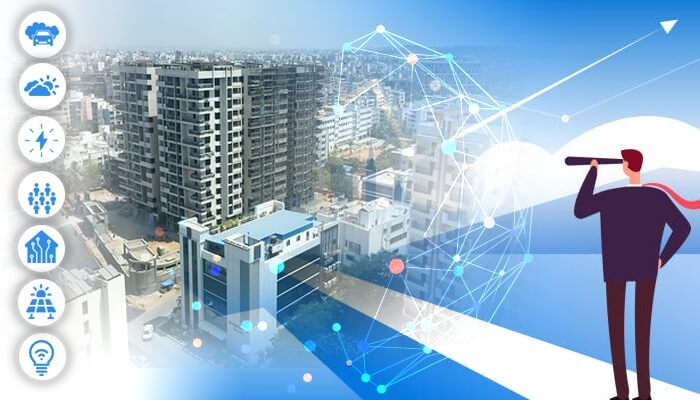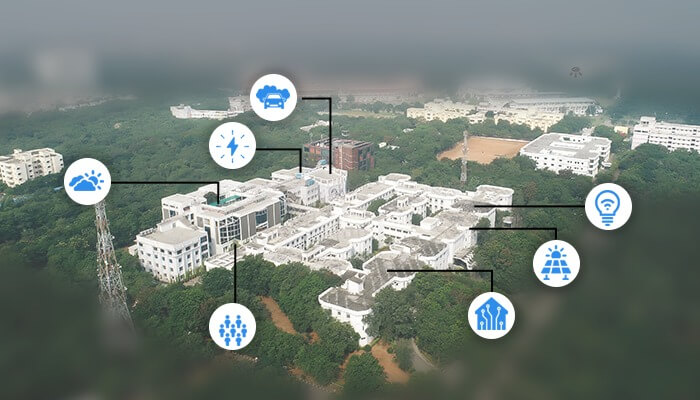Modern technology impacts life. But to witness its deployment first-hand for improving the quality of urban life, a tour of the Smart City Living Lab situated at the International Institute of Information Technology Hyderabad (IIITH) is warranted.
With recent alarming reports of the toxic levels of pollution in Hyderabad city, the city’s air quality is having its ignominious moment. But at the IIITH campus, air quality has been under scrutiny since 2019. With the Living Lab that has been set up at IIITH in collaboration with the European Business and Technology Centre (EBTC), the Amsterdam Innovation Arena (AIA) as well as the support of the Ministry of Electronics and Information Technology (MeitY) and the Government of Telangana, the campus is being used as a test bed for research and experimentation of IoT solutions for new-age or ‘smart’ cities. Here, every 15 seconds, the server gets updated with information on air quality parameters. Air quality, however, is just one of the parameters to measure quality of life. Water management, energy consumption, and weather conditions are among the others that are under continuous surveillance.
IoT Applications
For water quality measurement, the turbidity, TDS and pH levels are tracked every 4 hours. Similarly, to prevent water wastage and for its efficient utilisation, water quantity monitoring devices capture information every minute. For forecasting weather, monitoring parameters such as wind speed, its direction, air temperature, humidity and rainfall are important. A range of devices that capture this data have been installed across the IIITH campus transmitting information every minute. For monitoring energy, the Living Lab collects data from conventional energy sources – electricity consumed via lights, fans and other typical electrical appliances – as well as from solar energy. According to Anuradha Vattem, Lead Architect of the Living Lab space, “A continuous monitoring of energy consumption is important in order to achieve better efficiency in consumption patterns.” These energy measuring nodes transmit data at regular intervals of 15 minutes and one minute as per the requirement. With the continued presence of the pandemic, the centre has also recently begun its efforts in crowd monitoring via security cameras installed on campus. These help to count the number of people, number of mask violations if any, and group gatherings violating the mandatory safe distance norms. It has particularly been useful to identify violators and help keep the campus Covid-19 outbreak in check. Data from all these sources is presented on a live dashboard that can be tweaked to drill down to levels of granularity. It serves as an easy, one-stop solution to visualise all the current operations on campus.

OneM2M Standard
With data from a multitude of nodes being constantly transmitted at regular intervals to the Living Lab, it necessitates a middleware layer between the array of heterogenous sensors from IoT devices and the applications running on it. The Living Lab project uses the OM2M platform which follows OneM2M global standard – a platform that has incidentally been adopted nationally and across the globe. “The nodes that have been deployed across campus use different communication protocols like HTTP, Modbus, LoRaWAN, Bluetooth and others. By adopting the OneM2M standard, it is possible to achieve data interoperability independent of the underlying communication technologies,” explains Shubham Mante – an M.S by Research student who has been working on OneM2M from the start. According to Suhas Vaddhiparthy, another research student who is dealing with the integration of transmitted data, “In addition to interoperability, OM2M platform has many more features like subscription to streamline the data collection process and notification to alert the users about the current working status of the nodes”. Currently a data warehouse is being developed in order to store the voluminous sensor data by integrating it with the OM2M platform.
Sharing Data
In order to facilitate open data exchange among all the Smart City stakeholders, the Indian Institute of Science, Bangalore has initiated a multi-disciplinary program known as the India Urban Data Exchange (IUDX). It’s mission is “to leverage data and promote data sharing using a robust platform to solve everyday problems faced in city governance and by its citizens, and improve city infrastructure and services”. With its objectives aligned, IIITH’s Living Lab has been collaborating with the IUDX team for seamless data exchange between IIITH’s data monitoring systems and data consumers across the country.

Sarita Chebbi is a compulsive early riser. Devourer of all news. Kettlebell enthusiast. Nit-picker of the written word especially when it’s not her own.


Next post